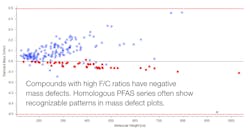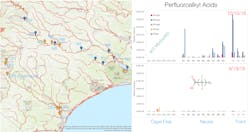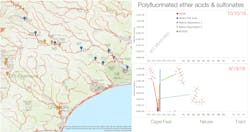The latest technology can help achieve a deeper understanding of PFAS
This article explores some of the latest U.S. Environmental Protection Agency (EPA)-approved tools and techniques, demonstrating how analytical laboratories can harness the latest technology to quantify both known and unknown PFAS more reliably and efficiently.
The PFAS Problem
Per- and polyfluoroalkyl substances (PFAS) are a primary group of contaminants of concern. This collection of manufactured, large, and complex ‘forever’ chemicals contain strong carbon-fluorine bonds making them extremely stable and likely to bioaccumulate. PFAS have already been linked to an array of health concerns, including increased cholesterol levels, decreased vaccine responses in children, changes in liver enzymes, increased risk of pre-eclampsia, small decreases in infant birth weights and increased cancer risk, and more recently the U.S. Environmental Protection Agency (EPA) issued a proposal to designate two of the most widely used PFAS as hazardous substances: perfluorooctanoic acid (PFOA) and perfluorooctanesulfonic acid (PFOS))
Having a wide variety of applications, PFAS are found in numerous products, from firefighting foam, non-stick cookware, carpet treatments and cosmetics. It’s easy to see how these compounds can end up in water supplies. To date, more than 9,000 PFAS have been identified, but many more unknown compounds are being discovered in water and soil analysis every year.
Since PFAS pose a risk to human health, governments have expanded monitoring legislation to ensure that producers and other industrial users are discharging wastewater within safe limits to safeguard drinking water supplies.
However, monitoring has traditionally been complex and time-consuming. With maximum contaminant levels (MCLs) set at very low (ng per liter) concentrations, accurate detection and quantification, even of known PFAS, are difficult.
Challenges in PFAS Analysis
Analytical scientists face five main challenges when analyzing PFAS:
Background contamination
PFAS are ubiquitous and are found in almost all laboratories, in clothes, lab equipment, containers, and analytical equipment. Since lifetime health advisories are set so low (4 parts per quadrillion for PFOA and 0.02 parts per trillion for PFOS), even a trace amount of background contamination can skew results.
Sample preparation
Due to the complexity of sample matrices and the number of manual steps needed in methods that require sample preconcentration with solid-phase extraction, interference and skewed results are common.
Multiple complex steps mean that extraction efficiency can vary greatly between compounds, and this limits reproducibility. Since target compounds can adhere to surfaces during sample preparation, some may never make it to the separation stage.
Analysis
Low detection levels mean that highly sensitive equipment and techniques are needed. But this is only part of the story. With the number of known PFAS compounds ever-increasing, obtaining standard reference material can be a challenge, yet this is important for accurate measurement and quality control.
For regulated methods, data analysis is reasonably simple. For methods that aim to identify new/novel compounds, however, backend analysis must be able to process large amounts of data. Without robust and meaningful processing, gathered data becomes redundant and valuable information is lost.
Methods
Regulatory standards are constantly evolving to incorporate emerging PFAS compounds, requiring new methods to detect them most accurately.
Installing new, compliant instruments and workflows needs considerable investment, training and transition time. However, the efforts pay back quickly: simpler workflows need less expertise and hands-on involvement, and this leads to increased accuracy, efficiency and productivity.
Multiple outputs
PFAS analysis, when following regulatory methods with prescribed procedures and target compounds, is generally straightforward. Where PFAS analysis becomes more complex is when unidentifiable peaks emerge, indicating that unknown PFAS may be present. Characterizing these compounds requires additional techniques with high resolving power, above and beyond traditional methods.
In the face of these challenges, analytical teams need sensitive, fast analysis delivered through robust equipment that is easy to use and combined with automated, end-to-end workflows.
Regulations are constantly evolving and there are increasing concerns about emerging PFAS that could be missed with traditional methods. Although it can be tempting to continue using tried and tested methods, these techniques may not be able to deliver the requirements for modern PFAS analysis and the new regulations that govern their detection.
Technology Advancements
New advances in PFAS preparation, separation, detection and data analysis have been followed closely by regulatory bodies, such as the EPA.
Some of these practices now have EPA-approved methods. Similarly, standards organizations, such as the American Society for Testing and Materials (ASTM) have released methods that further align PFAS analysis requirements on a global scale.
Sample preparation
Solid-phase extraction (SPE) has is one technique for sample preparation for drinking water analysis and is stated in EPA-approved methods 537.1 and 533.
This technique simplifies complex matrices and concentrates the sample, thereby reducing interference. The analytes of interest are further protected from background contamination by using PFAS-free materials in sampling bottles and other equipment.
Some advanced SPE instruments are fully automated, removing the errors that can creep in through manual preparation steps, and helping to increase accuracy, precision, and throughput in the separation, detection, and analysis stages.
Although SPE is the established sample preparation method for drinking water analysis, direct injection (based on dilution, filtration and acidification) can be used for LC-MS/MS analysis of groundwater, surface water and wastewater, based on EPA 8327 or ASTM D7979 methods. This further simplifies the workflow and increases productivity.
Separation and detection
Analysts following the latest methods for PFAS analysis can choose liquid chromatography with tandem mass spectrometry (LC-MS/MS) for separation and detection.
Triple quadrupole technology provides the required specificity to focus on PFAS compounds of interest, even at low MCLs, and deliver improved detection limits within complex matrices.
The real strength of LC-MS/MS lies in targeted PFAS analysis; it can deliver fast, sensitive and robust analysis with high throughput when users follow established methods for known PFAS.
For targeted LC-MS/MS analysis performed using triple-quadrupole-based instrumentation, only the presence or absence of targeted compounds can be determined, as the remaining compounds are filtered out. This means that other fluorinated species will go undetected.
Combustion ion chromatography can be used to determine the levels of total absorbable fluorine. If the mass balance exceeds that of the PFAS detected from the LC-MS/MS analysis, then unknown PFAS are likely present. Suspicious samples can then be further characterized using high-resolution accurate mass spectrometry (HRAM).
HRAM
The ultra-high-resolution offered by HRAM allows for the detection of other potential fluorine-containing compounds in the full scan analysis. The high resolution and mass accuracy obtained with HRAM provide improved specificity to help resolve matrix interference and reduce the possibility of false-positive or false-negative results.
This means that known PFAS targets can be monitored, and unknown species detected in one workflow. HRAM can also provide retrospective analyses of previous samples to drive deeper insight.
Although HRAM can be used for both targeted and untargeted PFAS analysis, the fast throughput delivered through LC-MS/MS make this technique the most cost-effective and efficient for a restricted list of known PFAS targets.
Uncovering Insights with Data Analysis
Thanks to technological advances and the ability of software to manage big data through automated algorithms and machine learning, PFAS separation and detection can provide deep levels of insight.
HRAM offers the ability to screen for other PFAS compounds that are not part of the routine analysis target list (suspect screening). This is accomplished by using PFAS compound databases in combination with curated MS/MS spectral libraries, without the need for additional reference standards.
These deep fragmentation libraries help build knowledge about unknown PFAS in a semi-automated way. As new PFAS are identified, historical HRAM outputs can be screened to identify these new compounds retrospectively.
These new advances now provide analytical teams with sensitive analysis and automated workflows that enable reliable results.
State-Wide Water Quality Monitoring
North Carolina has known sources of PFAS contamination, including manufacturing plants and firefighting foam users.
When elevated levels of GenX compounds (a group of shorter chain PFAS substitutes with allocated reference doses) were found downstream of a chemical manufacturing plant in the Neuse River, the North Carolina state legislature set up funds to monitor watersheds.
In 2018-2019, Duke University and North Carolina State University embarked on a project to analyze PFAS in drinking water from 405 state-wide surface and groundwater sources. The project aimed to measure the concentration of known PFAS in drinking water, but also detect non-targeted compounds, particularly those in the GenX category.
Using the new health goal of 140 ng/L set in 2017 for GenX in drinking water by the North Carolina Department of Health and Human Services, the study collected sequential sampling of drinking water sources across the state.
25-30 water samples per week were analyzed through direct injection into the Thermo Scientific™ Vanquish™ Ultra-High Performance Liquid Chromatography (UHPLC) system followed by detection in the Thermo Scientific TSQ Altis™ Triple Quadrupole Mass Spectrometer. Following separation and detection, the Thermo Scientific Compound Discoverer™ software was used in combination with the mzCloud™ fragmentation library to identify and quantify 48 known PFAS and indicate the presence of unidentified compounds.
An untargeted approach was also taken, using the Thermo Scientific Orbitrap Fusion™ Lumos™ Tribrid™ Mass Spectrometer, a type of HRAM equipment. Mass defect filtering was used to find unknown PFAS compounds in HRAM data that were not present in the targeted lists (Figure 1).
Of the PFAS identified, most were legacy PFOA and PFOS compounds rather than emerging PFAS. Ether acids and ether sulfonates were measured at elevated levels and could be traced back to a chemical plant in Cape Fear; objective and traceable evidence of this kind is invaluable to governments when addressing issues with possible polluters.
Although PFAS levels were low in nearly all areas, one well in Maysville showed PFAS signatures for likely contamination by aqueous film-forming foam. As this was the single source of drinking water for the town, the finding enabled the government to immediately switch the drinking water supply to a source in a neighboring county, thereby protecting residents.
More noteworthy results were seen following Hurricane Lawrence, which caused extensive flooding in the state in 2018. Fewer PFAS were detected during the flooding — but, a month later, interesting patterns emerged.
A similar trend was seen with perfluoroalkyl acids (Figure 3). Although low concentrations were detected at the height of the flooding, elevated levels were identified at certain sites a month later.
At one site, close to the Chemours manufacturing plant along the Cape Fear River, elevated Gen-X levels were found. Although the manufacturing of PFAS at this site had halted, it seemed that the flooding washed compounds from contaminated sites into the waterways (Figure 4).
Embracing New Technology
As the number of identifiable and unknown PFAS continue to increase in number, the need for effective methods of detecting and characterizing these compounds becomes ever more important.
The latest SPE techniques, ultra-high-performance LC-MS/MS and HRAM systems, and automated, algorithm-based analysis tools make targeted and non-targeted PFAS detection more effective than ever. The great news is that analytical chemists already have access to these tools and techniques, and many are already EPA-approved.
In the quest to protect waterways and address genuine human health concerns, effective methods need to be adopted as standard.
Not only will analytical laboratories reap the rewards of more accurate and reliable tests, but they will also benefit from more efficient methods that drive greater productivity, and reduce the cost and time taken to process each sample.
About the Author
Scott Pritchett
Scott Pritchett is the food and beverage marketing manager for Thermo Fisher Scientific.




